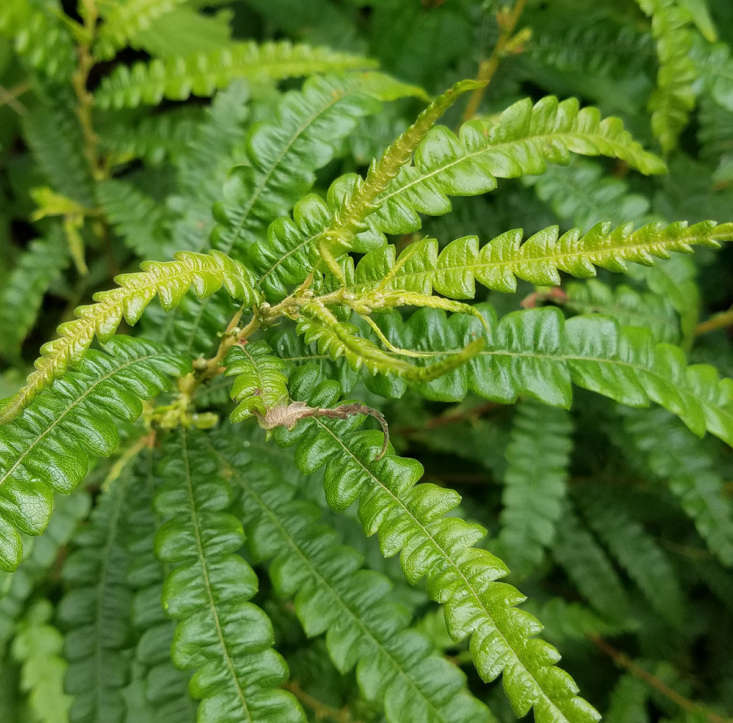Sweetfern, Comptonia peregrina
When most of us think of scent in the garden, we think of perfumed flowers. And flowers are wonderful (if short-lived). But what about aromatic foliage? Choosing a shrub with fragrant leaves gives us a source of herbal pleasure that lasts many months longer than the ephemeral seasonal scent of flowers. Sweetfern (Comptonia peregrina), a North American shrub masquerading as a fern, is beginning to edge onto the gardening radar. It belongs to the Myricaceae (wax myrtle, or bayberry) family, whose leaves are redolent of resinous spice.
Read on to learn more about the uses of sweetfern and how to grow this native shrub in your garden.
Photography by Marie Viljoen, unless otherwise noted.

The shrub grows in disturbed woodland sites where downed trees have brought sunlight to the forest floor, along roads in poor soil, in pine barrens, and in open meadow areas right up to the edge of fresh water. Sweetfern likes acidic soil, and can tolerate a lot of moisture as long as it drains well. Once established, it is also drought tolerant. The long narrow leaves of this attractive deciduous shrub do resemble miniature fern fronds, and their distinctively herbal scent when crushed makes this plant so appealing.
Sweetfern is an exceptionally cold-hardy shrub (from USDA zones 2 to 6), making it an unusual and tough choice for cold-climate gardening.
Prairie Nursery sells four-inch pots of sweetfern for $8.99

In my new cookbook, Forage, Harvest, Feast, I have devoted a chapter of recipes to sweetfern’s use as an herb. I grow it in my Brooklyn backyard so that the useful leaves are always within reach. This is a plant that deserves renewed culinary attention.

The young tender leaves of sweetfern appear a few weeks later. Chop them as you would an herb such as parsley or cilantro, although their intensely fresh hay-like and resinous scent resembles neither. I like to whip them into compound butters to season delicate seafood, such as scallops, or as a thick crust for roasting lamb.


In fall, sweetfern’s leaves turn a deep and burnished copper, making them a colorful asset in the late-season garden. When chilly evenings return, hardy sweetfern leaves are my herb of choice for a warming toddy after hours of garden clean up, and cold fingers.

Cheat Sheet
- Several Native American tribes used a sweetfern infusion as a topical antidote to poison ivy.
- Like legumes, sweetfern is able to fix nitrogen, hence its success in poor soils.
- The burr-like summer fruits contain nutty kernels that make a flavorful snack.
- Once established, sweetfern is a zero-maintenance plant.
- Sweetfern foliage is (largely) deer-resistant.
- While it deserves a place in our edible gardens, sweetfern is also useful for pure foliage appeal.
- When happy, the plant propagates by underground runners, forming new shrubs that are clones of itself.
- Native plant nurseries stock sweetfern, and more sellers will as awareness of this useful shrub grows: Ask for it.

Keep It Alive
- Grow sweetfern in full sun or semi-shade.
- Sweetfern dislikes having its roots disturbed, but the reason is not well understood—transplant your nursery specimen very gently.
- Slightly acidic soil is best, but sweetfern will tolerate neutral soils.
- Excellent drainage is key. Sandy soil is good, but clay soils are not.
- Sweetfern is slow growing, so buy a larger nursery specimen for instant gratification. Otherwise, be patient.
- To propagate your own shrubs, take root cuttings and pot them up in a gravelly mix.
For more growing tips, see Bayberry: A Field Guide to Planting, Care & Design in our curated guides to Shrubs 101. Read more:
- Everything You Need to Know About Shrubs
- English Boxwood: Is It Worth It?
- The Wildcrafting Brewer: A Guide for Botanical Alchemists











Have a Question or Comment About This Post?
Join the conversation